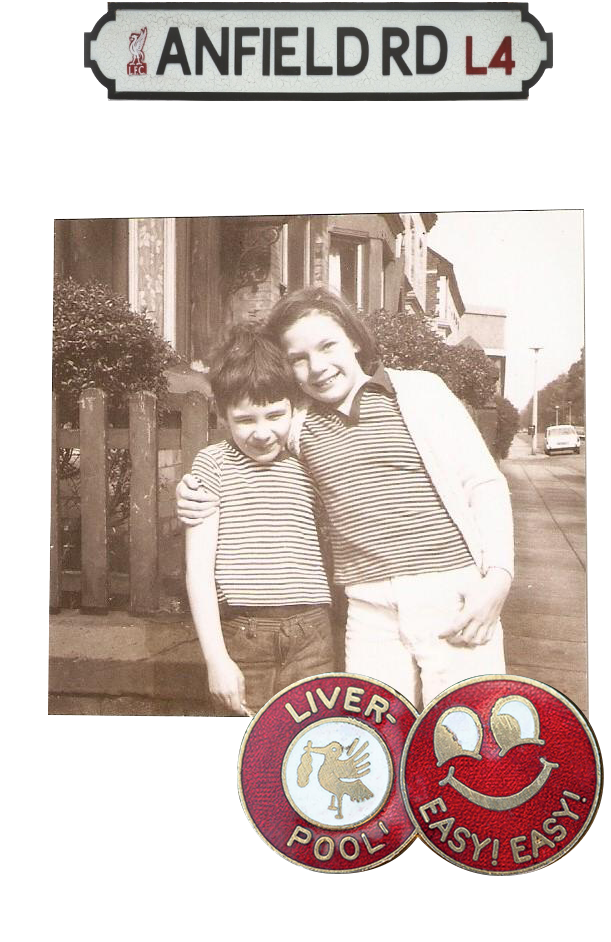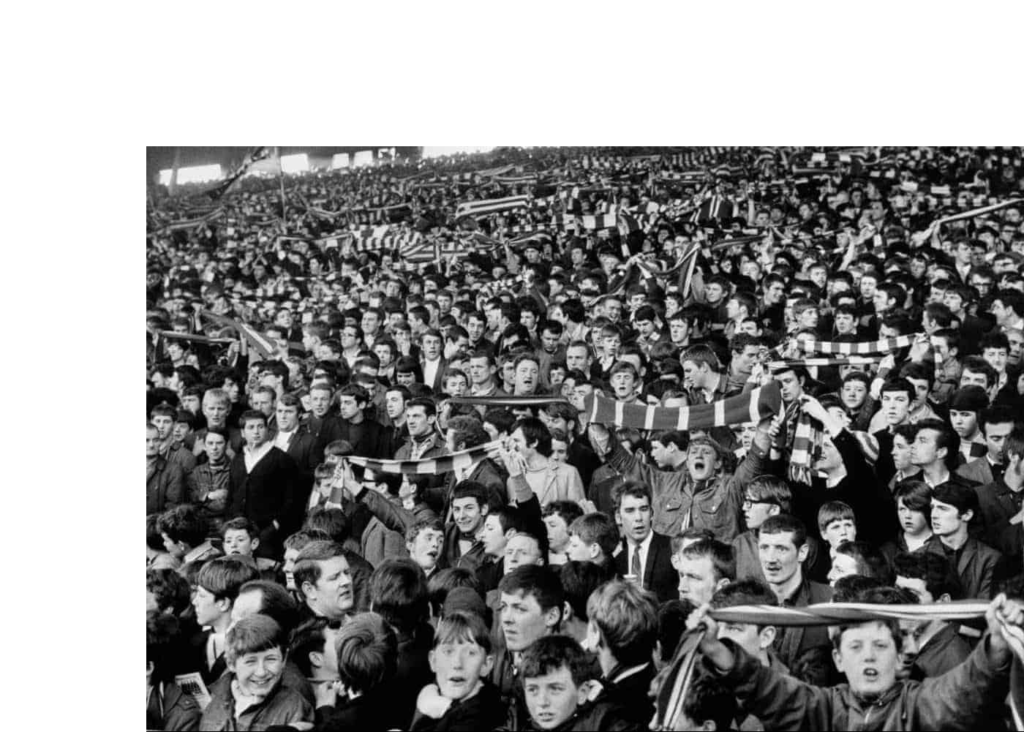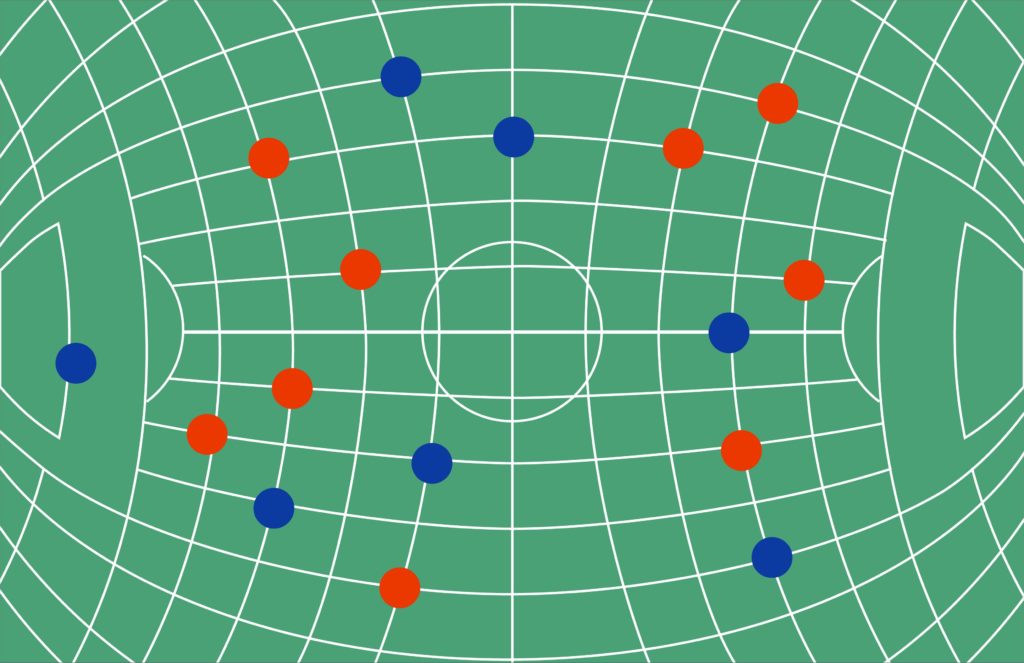In her book Communal Luxury from which this edition of Making and Breaking takes its title, Kristin Ross describes how the Communard vision was one where in the future, everyone “would have his or her share of the best.”1 This essay is about my own childhood experience of just that. How it came about as an accident of birth, how it was shared and experienced and what – if anything – it suggests about how we might think about social wealth in future.
I was born next to a football ground – Anfield – in the early 1960s just as the team, Liverpool FC, began its road to dominance of the English game in the following decade. The club’s legendary manager Bill Shankly had taken over in 1959 and the club had only just emerged from a stint in the second division of English football. Progress was rapid. My earliest football memory was Liverpool winning the FA Cup in 1965 when my mother, far too nervous to watch what was one of the few football matches ever televised live in those days, took us all for a day out to Chester Zoo rather than suffer the agonies of watching. We learned the result on the bus on the way home.
When I say “next” to a football ground, I was born on Anfield Rd, a block away from the ground (as me and my older sister are demonstrating below). It was close enough that you could leave the ground at the end of a match and be home in time to see the result read out on the television. But while Anfield was a relatively modest sized ground in those days, far from its spaceship-like appearance today, it is hard to overestimate how fully it was part of our neighbourhood.

At the time, when new players joined the club, they generally took lodgings with a landlady on Anfield Road – a few blocks from our house. It was possible to see young footballers in local pubs and betting shops, though for us kids it was more common to see them when we strolled up the ground to collect autographs in the summer or went to the Melwood training ground to watch the players put through their paces. After morning training, some of them would have a kick about in the park with local kids. When Liverpool were playing at home, our back yard was full of supporters’ bikes which we “looked after” for sixpence. Once, when I injured my hand, my mother took me up to the ground to have it looked at, rather than take me on the bus to our family doctor.
Liverpool is generally regarded as a football-mad city. It was common to ask other children at school if their parents were supporters of Liverpool or Everton and very uncommon to get the reply, “they don’t like football.” More usually the response involved some complex family history along the lines of “my dad’s an Evertonian, but his mum was Liverpool ‘cos of her uncle, who worked there on match days….” or some such variation. But it was proximity to the ground itself – and indeed to Everton’s ground just across the park – that made growing up in Anfield as a football fan so peculiar.
Nowhere was this more the case than in the phenomenon known as “three-quarter time,” when halfway through the second half of the match the gates were open to let supporters out and, if you were close enough, and we were, you could go and watch the final quarter of the match for free. This involved simply walking up the ground, entering through the open turnstiles and finding yourself a space on the – at that time – standing terraces. I often went up to the ground with my sister or cousins, but finding a space sometimes involved standing on your own, an experience I had regularly from the age of about 10 or 11. I was a fairly nervous kid and can remember being scared in the school playground or in the park as, despite my fondness for watching football, I had no sporting or physical ability whatsoever. Yet I cannot remember ever being scared at Anfield.

Though “three quarter time” didn’t represent any sort of club policy, it was simply crowd management rather than a “taster session” as at your local gym, it acted as a training ground for us young supporters. It was where you learned how to sing the songs, how to run up and down the terraced steps to avoid being trampled on as the crowd surged forward when a goal was scored and – frankly – how to get out of the way quickly when a man decides to urinate in public. After a couple of years we graduated to getting tickets and attending for the full game, either in the notorious “Boys Pen,” an area of the terraces reserved for children where fighting was more common than anywhere else in the ground, or in the other terraces , the famous Kop (for the fully graduated supporter) or the “Anfield Rd End,” where I went along with with my school mates for several years.
As adulthood approached, my friends and I got Saturday jobs and discovered pop music and nightclubs, we studied for university or (more likely) left school and went straight into the labour market. And Liverpool went from winning the FA Cup for the first time, to just over a decade in which it won three European (Champions League) trophies, six English league titles and a UEFA Cup. It began the first of many, relentless, expansions of the football ground in which my childhood home was demolished and my family was moved to the next street, where Liverpool FC briefly became our landlord. My father was actively involved in the campaign against the club’s expansion, though he would never have thought it made him less of a fan.
As I write, the Qatar World Cup, complete with air-conditioned stadiums and a rumoured cost of over $150 billion is in full swing and Liverpool FC fans are reading anxiously about a rumoured sale of the club from its current US-based owners to a consortium of Middle East petro states for something around $4 billion. The footballing world of the late 1970s, in all its good and bad ways, is difficult to imagine even if you were there, and impossible to reconstruct.

At this point some readers might say that it is not impossible to reconstruct such experiences. – you just have to look elsewhere for your sporting pleasures. That Kult football clubs like FC Pauli in Hamburg or non-league sides like Dulwich Hamlet are the way to go, that fan ownership and co-operative ownership must be encouraged, or that minority sports, away from the global juggernaut of Association Football, can offer the same feelings of connection and easy access. And to be clear, I’m in favour of all these things. And even of the idea that around 8 million of us could each find £500 to buy Liverpool FC. But it’s the particular juxtaposition of a Liverpool side, so embedded in a working class area that it didn’t need a “community outreach programme,” it was simply part of the community, while moving headlong towards a global elite, that I find illuminates some notions of communal luxury for me.
Firstly, it’s about recognising the commercial nature of lots of communal spaces – pubs, nightclubs, music venues, department stores and sports stadia. All run for profit; all providing feelings of belonging and even ownership. It is sometimes suggested that a more domestic version of capitalism made that possible. Your favourite football club was owned by a business – but it was likely to be the local scrap metal dealer or construction company owner – and very unlikely to be a foreign sovereign wealth fund. Does that make a difference? Possibly, but the fact remained that it existed in the commercial market and could be bought and sold at whim. Yet even under capitalism, state regulation protects certain communal assets – natural or cultural, but it rarely protects the communal commercial assets that can matter so much to us.
Secondly, access and ownership don’t have to be total, even partial and time limited encounters are valuable. The porousness of Liverpool’s FC ground to its neighbourhood was what strikes me looking back – the multiple access points, the ability to walk right up to the ground at any time, to hang about at the players’ entrance unbothered by security, the ability to get those free, precious 20 minutes inside. Ideally, we will see an expansion of community ownership in future, but free entry to certain groups (local school kids), at certain times (a sport like Test cricket can often manage this with a free fifth day) or for certain occasions, can create spaces where connections are made and a ‘share of the best’ is felt, even briefly. As Marks Banks has argued2 even in a future, post-fossil fuel, “degrown” world, we are likely to want some form of organised cultural economy (in which I include sport), together with some sense of what or who is aesthetically “good,” “interesting,” “the best” and so on, so questions of access are likely to remain.
And thirdly proximity – real proximity – close enough to walk is what really matters. I’ve no problem with national museums, or city centre theatres, with grand urban parks or especially not with the fading delights of the city centre shopping street – associated as all these things are with the notion of an occasional treat, not an everyday experience. But even in a world of over-production, we still need more communal spaces – more swimming pools, more skateboard parks, more gyms, more local markets – so that the everyday is infused with the possibility of communal activity, conviviality and joy. Inclusion is not enough – the absence of exclusion matters as well. Department stores however fancy can be welcoming to window shoppers and impecunious browsers; security guards in privatised shops malls are much less so. It is why so-called hostile architecture with its spikes and its noises and to deter the young, the homeless and the non-consuming should be resisted at every turn.
In a recent book on “left wing football clubs,”3 the authors argue that fans determine the culture of clubs more than owners do. If so, there is perhaps some hope to be gleaned in the reaction of football fans to the monstrous European Super League proposal. And interesting to see the arguments mobilised, about place, about class, about history and about ownership even by wealthy ex-players. As sports historian Tony Collins has written, working class men and women once found in football, “a communal gathering, a place to express local and class pride, and a 90 minute space in the week that was truly theirs, beyond the reach of the boss, the bureaucrat, and the moralist.“ It may already be too late, but if that is so, then spaces that can offer this will have to be created anew.

